REPRESENTASI WANITA SEBELUM DAN SESUDAH GERAKAN FEMVERTISING DALAM IKLAN PERAWATAN TUBUH
DOI:
https://doi.org/10.51804/deskovi.v3i2.801Keywords:
bahasa visual, citra merek, feminisme, femvertising, iklan, semiotika sosialAbstract
Representasi gender dalam iklan adalah bentuk manifestasi budaya dari siklus ideologi dalam masyarakat. Sejauh ini, keberadaan iklan telah terbukti menjadi media yang berpengaruh terhadap penggunaan bahasa, gambar dan kontruksi representasi untuk meyakinkan audiens dengan membentuk realitas dalam mempengaruhi keputusan pembelian. Beberapa tahun terakhir, istilah femvertising muncul sebagai upaya periklanan untuk menarik konsumen wanita. Secara visual maupun retoris, pesan-pesan iklan yang dibingkai dalam femvertising mempromosikan kesetaraan gender dan hak-hak wanita. Gerakan Feminisme gelombang ketiga yang berkembang saat ini, menciptakan perspektif baru milenial feminis dengan menganggap bahwa feminisme adalah bentuk kebebasan memilih dalam semua aspek kehidupan, baik kesehatan, karier, pernikahan hingga selera pribadi dalam penampilan. Membandingkan iklan dari tahun 1980-an dan 1990-an dengan iklan yang diterbitkan 5 tahun terakhir ini, akan menyajikan konteks tentang bagaimana pergeseran sosial mempengaruhi kontruksi iklan dan persepsi konsumen terhadap merek. Melalui analisis visual kualitatif, studi ini akan mengindentifikasi bagaimana kampanye iklan dikontruksi sebelum dan sesudah gerakan femvertising melalui pesan feminisme demi membangun ketertartarikan audiens perempuan. Hasil penelitian ini menunjukkan bahwa iklan-iklan perawatan tubuh sering menampilkan isu yang serupa, yaitu tentang nilai-nilai kepribadian dan kecantikan. Pergeseran nilai kecantikan dan kepribadian dalam domain yang lebih luas telah menyokong perubahan perspektif sosial terhadap perempuan menuju kesadaran feminisme.
Gender representation in advertising is a form of cultural manifestation of an ideological cycle in society. So far, the existence of advertisements has proved to be a media that affects the use of language, images and representation in order to convince the audience by shaping reality in influencing purchasing decisions. In recent years, the term femvertising emerged as an advertising effort to attract female consumers. Visually or rhetorically, the ad messages framed in a femvertising promote gender equality and women's rights. The third Wave feminism movement that develops today, creates a new perspective of feminist millennials by assuming that feminism is a form of freedom of choosing in all aspects of life, whether health, career, marriage to personal tastes in appearance. Comparing ads from the 1980's and 1990's with ads published in the last 5 years, will present a context on how social shifts affect ad construction and consumer perception of the brand. Through qualitative visual analysis, this study will identify how the advertising campaign was constructed before and after the femvertising movement through feminism messages in order to build a female audience's alignment. The results of this study show that the advertising of body care often displays similar issues, namely about the values of personality and beauty. The shifting value of beauty and personality in the wider domain has supported the change of social perspective on women toward the consciousness of feminism.
Downloads
References
Case, Lindsey. M. 2019. From Femininity to Feminism: A Visual Analysis of Advertisement Before and After the Femvertising Movement. Elon Journal of Undergraduate Research in Communication, Vo1. 10, No. 1, 35-45.
Drewniany B.L & Jewler A. Jerome. 2008. Creative Strategy in Advertising. United States of America : Thomson Wadsworth
Hidayati, Nuril. 2018. Teori Feminisme: Sejarah, Perkembangan & Relevansinya dengan Kajian Keislaman Kontemporer. Jurnal Harkat : Media Komunikasi Gender, 14 (1), 21-29.
Hunt, Alexandra. R. 2017. Selling Empowerment: A Critical Analysis of Femvertising (Senior Communication Honors Thesis). Di akses dari laman http://hdl.handle.net/2345/bc-ir:107483
Kress, G. & van Leeuwen. T. 2006. Reading Images : the Grammar of Visual Design (second ed), London and New York : Routledge
Kumalanungtyas, Nur & Sadasri, Lidwina. M. 2018. Citra Tubuh Positif Perempuan dalam Iklan Video Digital (Studi Femvertising pada IKlan Dove Real Beauty). Jurnal Diakom, Vo1. 1 No. 2, 62-73.
Olivia, Femi. 2010. Be A Diva: Atraktif (Terapi Kepribadian). Jakarta : PT Elex Media Komputindo
Russel, Thomas. 2013. Commercial Advertising: Six Lecture at The London School of Economic and Political Science. Diakses pada laman
Downloads
Published
How to Cite
Issue
Section
License
With the receipt of the article by DADJ Editorial Board and the decision to be published, the copyright regarding the article will be transferred to DADJ. The copyright transfer form can be downloaded here.
DADJ has the right to multiply and distribute the article and every author is not allowed to publish the same article that was published in this journal.

DESKOVI: Art and Design Journal is licensed under a Creative Commons Attribution 4.0 International License.
Under the following terms:
Attribution — You must give appropriate credit, provide a link to the license, and indicate if changes were made. You may do so in any reasonable manner, but not in any way that suggests the licensor endorses you or your use.






